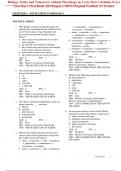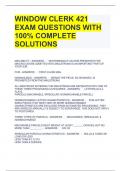Chapter One 1 CHAPTER 1 —INVITATION TO BIOLOGY
MULTIPLE CHOICE 1.Why did the scientists assume the plants and
animals they encountered in the cloud forest on
top of New Guinea’s Foja Mountains had
never been encountered by other humans
before?
a.these species were unknown to even the
native peoples
b.the animals were unafraid of humans
c.they found some species that were thought
to have been extinct for decades
d.none of these answers are correct
e.all of these answers are correct except d.
ANS: E PTS: 1
DIF: Easy
OBJ: Bloom's Taxonomy: Knowledge
TOP: THE SECRET LIFE OF EARTH
2.The current rate of extinctions is about ____
times faster than normal.
a.10
b.100
c.1000
d.100, 000
e.1, 000, 000
ANS: C PTS: 1
DIF: Easy
OBJ: Bloom's Taxonomy: Knowledge
TOP: THE SECRET LIFE OF EARTH
3.The species extinctions taking place today are
being caused by ____ activities.
a.human
b.volcanic
c.plate tectonic
d.extraterrestrial
e.geothermal
ANS: A PTS: 1
DIF: Easy
OBJ: Bloom's Taxonomy: Knowledg e
TOP: THE SECRET LIFE OF EARTH
4.Which of the following represents the most
correct order of the organization of life from
the smallest unit to the largest?
a.atoms → molecules → cells → organisms
→populations → communities →
ecosystems → biosphere
b.atoms → molecules → cells → organisms→communities → populations →
ecosystems → biosphere
c.atoms → molecules → cells → organisms
→populations → ecosystems →
communities → biosphere
d.communities → biosphere → organisms →
ecosystems → populatio ns → cells →
molecules → atoms
e.biosphere → organisms → communities →
ecosystems → populations → molecules
→cells → atoms
ANS: A PTS: 1 DIF: Difficult OBJ: Bloom's Taxonomy: Comprehension | Bloom's Taxonomy: Analysis TOP: LIFE IS MORE THAN THE SUM OF ITS PARTS
5.Which of the following organization levels is
the least inclusive?
a.population
b.community
c.cell
d.atom
e.molecule
ANS: D PTS: 1
DIF: Easy
OBJ: Bloom's Taxonomy: Knowledge |
Bloom's Taxonomy: Comprehension
TOP: LIFE IS MORE THAN THE SUM OF
ITS PARTS
6.An ecosystem such as a forest in the Pacific
Northwest of the United States is made up of
a.plants, animals and fungi.
b.organisms and nonliving things.
c.rocks and minerals.
d.plants, protozoa, and fungi.
e.all of these.
ANS: B PTS: 1
DIF: Moderate
OBJ: Bloom's Taxonomy: Knowledge
TOP: LIFE IS MORE THAN THE SUM OF
ITS PARTSBiology Today and Tomorrow without Physiology 4e Cecie Starr Christine Evers Lisa Starr (Test Bank All Chapters, 100% Original Verified, A+ Grade) 2 Invitation to Biology 7. All of the following with one exception are part of an African savanna community. Select the exception. a. a pride of lions b. Elephant grass c. African wild dogs d. low fertility soils e. Zebras ANS: D PTS: 1 DIF: Moderate OBJ: Bloom's Taxonomy: Knowledge, Analysis TOP: LIFE IS MORE THAN THE SUM OF ITS PARTS MSC: Select the exception 8. Which of the following molecules are molecules of life? I. carbohydrates II. proteins III. nucleic acids IV. carbon a. I only b. I and II c. I and III d. I, II and III e. I, II, III and IV ANS: D PTS: 1 DIF: Moderate OBJ: Bloom's Taxonomy: Knowledge TOP: LIFE IS MORE THAN THE SUM OF ITS PARTS 9. A population is composed of individuals of a. the same species. b. interacting species of different kinds. c. interacting species and nonliving things. d. a single species interacting with nonliving things. e. all species found in a given area. ANS: A PTS: 1 DIF: Moderate OBJ: Bloom's Taxonomy: Knowledge; Application TOP: LIFE IS MORE THAN THE SUM OF ITS PARTS 10. Living organisms are members of all of the levels listed below. However, soil is a component of a. the community. b. the population. c. the ecosystem. d. the biosphere. e. both the community and the biosphere. ANS: C PTS: 1 DIF: Difficult OBJ: Bloom's Taxonomy: Knowledge | Bloom's Taxonomy: Analysis TOP: LIFE IS MORE THAN THE SUM OF ITS PARTS 11. Which of the following characteristics are shared by all living organisms? I. organization into cells II. adaptation to environmental change III. requirement for nutrients IV. DNA housed in a nucleus a. I and II b. I and III c. II and III d. I, II, and III e. I, II, III, and IV ANS: D PTS: 1 DIF: Difficult OBJ: Bloom's Taxonomy: Knowledge | Bloom's Taxonomy: Comprehension TOP: LIFE IS MORE THAN THE SUM OF ITS PARTS 12. Which of the following is a basic component of all of the others? a. cells d. organism b. organs e. organ systems c. tissues ANS: A PTS: 1 DIF: Easy OBJ: Bloom's Taxonomy: Knowledge, TOP: LIFE IS MORE THAN THE SUM OF ITS PARTS 13. Which of the following represents an activity within a population? a. a fox consuming a rabbit b. the absorption of nitrogen by bacteria and converting it to a form useful to plants c. a peacock spreading and shaking his feathers to attract a female d. moss growing on the north side of a large pine tree e. a virus causing rabies in a dog ANS: C PTS: 1 DIF: Difficult Chapter One 3 OBJ: Bloom's Taxonomy: Knowledge/ Comprehension/ Analysis TOP: LIFE IS MORE THAN THE SUM OF ITS PARTS 14. African elephants, lions, and zebras are all different species that can be viewed in zoos in separate enclosures. When they live together in an African savanna, they form a dynamic, interacting community. This dynamic living together of species is an example of a(n) _____ property. a. emerged b. expansive c. elaborate d. thermodynamic e. eclectic ANS: A PTS: 1 DIF: Difficult OBJ: Bloom's Taxonomy: Comprehension, Application, Analysis TOP: LIFE IS MORE THAN THE SUM OF ITS PARTS 15. All organisms fit into one of the two following categories. a. consumers and decomposers b. producers and decomposers c. producers and consumers d. scavengers and detritivores e. consumers and scavengers ANS: C PTS: 1 DIF: Moderate OBJ: Bloom's Taxonomy: Knowledge TOP: HOW LIVING THINGS ARE ALIKE 16. The dynamics of an ecosystem depends on two main processes: a. the cycling of energy and the unidirectional flow of nutrients. b. the unidirectional flow of energy and the cycling of nutrients. c. the multidirectional flow of both energy and nutrients. d. the unidirectional flow of both energy and nutrients. e. the cycling of both energy and nutrients. ANS: B PTS: 1 DIF: Moderate OBJ: Bloom's Taxonomy: Knowledge TOP: HOW LIVING THINGS ARE ALIKE 17. On a very hot day in summer, you go outside and take your temperature, it is 37 degrees Celsius. On another day, this time a very cold day in winter, you go outside and take your temperature, again it is 37 degrees Celsius. This example illustrates a. adaptation. b. cellular reproduction. c. respiration. d. homeostasis. e. digestion. ANS: D PTS: 1 DIF: Moderate OBJ: Bloom's Taxonomy: Knowledge | Bloom's Taxonomy: Application | Bloom's Taxonomy: Evaluation TOP: HOW LIVING THINGS ARE ALIKE 18. The DNA molecule is most similar functionally to a a. pair of scissors. b. flash light battery. c. cookbook. d. ballpoint pen. e. craft kit of ceramic tiles. ANS: C PTS: 1 DIF: Moderate OBJ: Bloom's Taxonomy: Knowledge/ Analysis TOP: HOW LIVING THINGS ARE ALIKE 19. Living organisms are distinct from nonliving things by which of the following features? a. continuous energy inputs b. complex molecular structure c. DNA that guides functioning d. sensing and responding to change e. all of these except complex molecular structure ANS: E PTS: 1 DIF: Moderate OBJ: Bloom's Taxonomy: Knowledge TOP: HOW LIVING THINGS ARE ALIKE 4 Invitation to Biology 20. Energy flow is one -way because a. all of the energy in an ecosystem stays constant b. the amount of energy a producer harvests is equal to the amount of energy consumers consume c. with each energy transfer, some energy escapes as heat d. energy cannot be created but it can be destroyed e. there is only one form of energy ANS: C PTS: 1 DIF: Moderate OBJ: Bloom's Taxonomy: knowledge, analysis TOP: HOW LIVING THINGS ARE ALIKE 21. Homeostasis is a. the ability to sense and response to change b. maintaining an internal environment within parameters that favor survival c. essential for all living things d. not found in nonliving things e. all of these ANS: E PTS: 1 DIF: Easy OBJ: Bloom's Taxonomy: Knowledge, Analysis TOP: HOW LIVING THINGS ARE ALIKE 22. Which of the following statements is true concerning DNA? a. DNA carries hereditary information. b. DNA is responsible for the similarity of all living things. c. DNA is responsible for the differences between all living things. d. DNA guides development. e. All of these statements are true. ANS: E PTS: 1 DIF: Easy OBJ: Bloom's Taxonomy: Knowledge TOP: HOW LIVING THINGS ARE ALIKE 23. All known species can be grouped into three domains. What are they? a. prokaryotes, bacteria, and eukarya. b. prokaryotes, archaea, and eukarya. c. plantae, bacteria, and archaea. d. bacteria, archaea, and eukarya. e. bacteria, archaea, and protista. ANS: D PTS: 1 DIF: Easy OBJ: Bloom's Taxonomy: Knowledge TOP: HOW LIVING THINGS DIFFER 24. Members of which of the following groups can be single -celled producers? a. plantae b. protista c. bacteria d. bacteria and protista e. bacteria and plantae ANS: D PTS: 1 DIF: Moderate OBJ: Bloom's Taxonomy: Knowledge, Application TOP: HOW LIVING THINGS DIFFER 25. Plants perform photosynthesis by using the energy of ____ to power production of sugars from ____ and ____ molecules. a. organic molecules; oxygen; water b. organic molecules; carbon dioxide; water c. sunlight; carbon dioxide and oxygen; water d. sunlight; oxygen; water e. sunlight; carbon dioxide; water ANS: E PTS: 1 DIF: Easy OBJ: Bloom's Taxonomy: Knowledge | Bloom's Taxonomy: Comprehension TOP: HOW LIVING THINGS DIFFER 26. You look into a powerful microscope and see a single -celled organism that is very small, has a cell wall, and no nucleus. You conclude that this organism belongs to the domain, a. Eukarya. b. Eukarya or Archaea. c. Archaea. d. Bacteria. e. Arachea or Bacteria. ANS: E PTS: 1 DIF: Moderate OBJ: Bloom's Taxonomy: Knowledge, Comprehension, Application, Analysis TOP: HOW LIVING THINGS DIFFER





